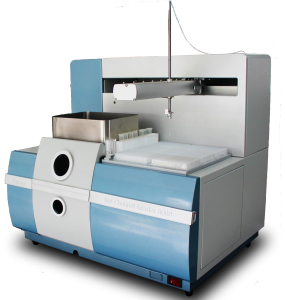系列介绍
ICR 8100 初级药物筛选技术
Aurora的离子通道阅读器(ICR)结合多功能性、精密度和灵敏度与微进样工艺和液体处理技术,为离子通道研究人员创造了高通量的筛选解决方案,填补了自动化膜片钳无法填补的空白。ICR8000是一种更经济实惠的、中等吞吐量的离子通道筛选系统,对于台式机来说足够紧凑,同时保留了广泛的实用性。
用途
ICR 8100可用于评估电压门控(hERG、BK/SK、Kv1.1、1.4、1.5、KCNQ、2P等)和配体门控(KATP、nAChR等)离子通道,以及离子泵和转运体(如Na+/K+-ATP酶),使研究人员能够加速药物开发,用于治疗和预防与这些关键膜转运蛋白相关的疾病。
目前的应用包括阳离子氯共转运蛋白(CCC)的评估,CCC是神经元氯稳态的关键组成部分,是细胞体积和神经元兴奋性的重要调节因子。因为CCC是电中性的,它们的活性不能用自动膜片钳技术来测量。ICR 8000能够通过测量细胞溶质和细胞外离子的绝对浓度来获得这些和其他通道及转运蛋白的高通量活性测量,这一技术独立于依赖于电压操纵的方法,并且是对这些方法的补充。
产品方案

ICR 8100 离子通道阅读器
特点&优势
- 高达5000孔每天,可编程及自动化的解决方案
- 自动稀释,校准和清洗
- 适用于常规自动化
- 不需要样品稀释
- 高灵敏度
- 在线稀释
- 消除与荧光相关的猝灭效应
- 无需使用危险的放射性同位素
- 避免Rb半衰期短造成的工作限制
- 非常适合hERG通道分析
- 可评估电致和电中性转运体
技术参数/通道/盘面示例/模块示例
规格
|
通量 |
高达5000孔每天 |
燃料来源 |
乙炔/压缩空气 |
|
单通道 |
一次测量一个样本 |
选配 |
叠盘机/条形码阅读器 |
|
最小样本体积 |
50µl |
灵敏度 |
0.05 ppm检测限 |
|
载体 |
96/384微孔板 |
精度 |
<5%CV |
|
体积cm |
高67 X 宽55 X 深37 |
|
|
常见问题
非放射性通量分析被认为是一个高通量的解决方案,以研究广泛的膜蛋白,包括电中性目标,传统的电生理学无法应用。通量分析能够建立与膜片钳相同的药物效力等级。
膜蛋白靶点包括电压门控和配体门控离子通道、共转运蛋白和泵。
表达感兴趣的离子通道的细胞在被送入ICR之前要经过一系列的程序,包括示踪剂装载、药物孵育、清洗、处理和裂解。ICR可以完全自动化样品分析程序
ICR8100的最小样品装载量为50ul,ICR.12000的最小样品装载量为20 ul。ICR 12000每天处理60000孔,而ICR8000每天处理5000孔。ICR 12000还有一个可选的叠盘机。
What plate formats are compatible with the lCR?标准96和384孔板。Standard 96 and 384 well plates.
我们的客户包括Amgen , Merck,AstraZeneca, Roche, Pfizer,不列颠哥伦比亚大学、河北医科大学等。


